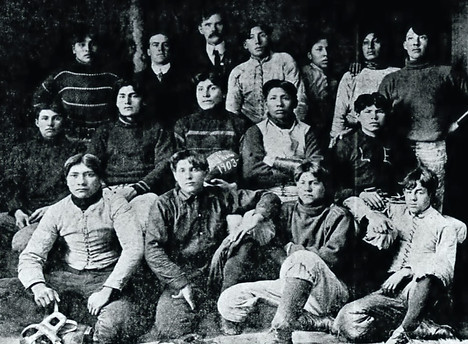Fort Shaw Indian School
Fort Shaw, Montana
1892-1910
E-Travel
Full Court Quest by Linda S. Peavey is a history of the girls’ basketball program with emphasis on participation in the 1904 Centennial Exposition. The Great Falls Tribune covered many school events. “Champions: The Girls of Fort Shaw” appeared in Montana Women’s History.
History
Fort Shaw Indian School was based on the Carlisle model. For half of each day, students were taught “all of the common English branches.” Some of these included arithmetic, history, English, spelling, letter writing and map drawing. For the other half of the day they were taught “how to make a living by work as do the white people.” Boys were taught blacksmithing, shoe making, carpentry and tailoring—in addition to agriculture. Girls were taught housework and dressmaking. In addition, students were expected to perform such work as was required to maintain the school.
Classes began on December 27, 1892 for 56 students. This number grew to 192 by 1893 and to 364 by 1901. Students were as young as five and as old as 18 or more. The curriculum extended only to the eighth grade, but some students repeated a grade several times. Seven tribes were included in enrollment, with the Blackfoot tribe being most prevalent.
In the 1893-94 school year students developed an orchestra and a brass band, later adding a mandolin club and a glee club. Soon, no parade, fair, or festival in the area was complete without performances by Fort Shaw Indian School students.

When the school was invited to participate in the 1904 Lewis and Clark Centennial Exposition in St. Louis, the students raised money for the trip by giving entertainments of basketball, gymnastics, band concerts, pantomimes, comedy, and choral recitations around the state. The girls’ basketball team performed “The Famine” from Hiawatha twice daily as part of the Exposition.
By 1910 enrollment at Fort Shaw Indian School was declining, so the school was closed.
F.S.I.S. basketball team in native costume to perform "The Famine" at the 1904 World Fair. Image by Andrew P. Williams from the Missouri Historical Society.
Bricks and Mortar
Fort Shaw (originally Camp Reynolds) was built in the summer of 1867 as an army base to protect settlers and miners in Montana against Indian attacks. In April 1892 Fort Shaw was abandoned by the army and transferred to the Department of the Interior. Twenty-four buildings were turned over to the new Indian school. Faculty and staff were housed in the former officers’ quarters; students were housed in the barracks buildings. The main school building was a 70’ x 41’ frame structure. The extant photo shows two stories over a stone basement. A 26’ x 41’ annex was added. An 1899 newspaper accounts show that the dorms were overcrowded and poorly ventilated, leading to outbreaks of illnesses. Building upgrades were performed by student carpenters.
After the Indian school closed, the campus was turned over to the local school district. The school buildings are gone. The few remaining buildings of Fort Shaw are on the National Register.

1914 image of the classroom building and dormitories for Fort Shaw Indian School. Hmdb.org The Historical Marker Database. Photo by Barry Swackhamer.
Sports
Team Name: Indians
School colors: Royal Purple, Old Gold, and Red
The 1896 commencement featured athletic contests, including a 100 yard dash and a hurdle race. In 1898 15-year-old Richard Pickett ran a 10.25 100-yard dash. Football was introduced to the school in 1900, with a team that defeated the University of Montana 5-0 and tied Butte High School. The Indians regularly played the University, the Agriculture College, Montana Wesleyan College and Butte Business College in addition to the area high schools—who were allowed to use their alumni in those games.
The sport for which Fort Shaw is best known is women’s basketball. Josephine Langley, hired as an “Indian Assistant,” introduced basketball to Fort Shaw in 1902. The 1902-03 team learned quickly, compiling a 9-2 record, defeating all Montana opponents, including the university and the agricultural college.

Newspaper image of the 1903 F.S.I.S. football team. Image from the Great Falls Tribune.
Note: Images are used in accordance with their “terms of use” as I understand those terms. Recopying or republishing these images may be restricted or forbidden.
After the 1903-04 school year, members of the basketball team were among students who traveled to St. Louis as part of the Lewis and Clark Exposition. While women’s basketball was not a part of the 1904 Olympics, held in conjunction with the Exposition, Fort Shaw defeated the Illinois champion O’Fallon 14-3 and the Missouri all-star team from St. Louis twice 24-2 and 17-6 to be declared Champions of the World.